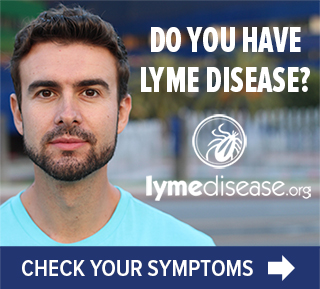Your Lyme Disease Symptom Checklist was successfully submitted. You will receive an email with a pdf attached that you can print out and take with you to your next doctor’s appointment. Please know that the information contained in the Symptoms Checklist is for educational use only. It should not be used as a substitute for professional medical advice, diagnosis or treatment. Share your checklist responses with your physician to determine if you or your child have Lyme disease.
Please consider taking a short survey.
LymeDisease.org is the most extensive communications network for Lyme disease and the most trusted source of information by patients. Our big data project, MyLymeData, is the largest study of Lyme disease ever conducted. Please answer the 3 questions below to help us improve our work.
Share Lyme Disease Symptom Checklist on your website
If you have a website, you can help by posting a Lyme Disease Symptom Checklist banner on your website. If the size below does not fit into your website design, we will make a banner to fit your dimensions. Email us at info@lymedisease.org to let us know your custom size.
You should consider Lyme disease if you have any of the symptoms of early Lyme disease. The risk of having Lyme disease increases if you were exposed to Lyme disease, recall a tick bite or had early symptoms (particularly the rash). You should also consider Lyme disease if you have any unexplained symptoms of Late Lyme Disease, especially if you have two or more symptoms.
Delay in diagnosis is common. Approximately 60% of patients with chronic Lyme disease are not diagnosed for at least 2 years. Diagnostic testing for early Lyme disease (within a month of exposure) is widely considered unreliable and is not recommended by the CDC because patients have not developed the antibodies the test detects. In late Lyme disease, antibody levels may decline. Roughly 50% of negative Lyme tests are false negatives.
In Lyme disease, there are two standards of care reflected in the medical guidelines of two specialty societies: the International Lyme and Associated Diseases Society (ILADS) and the Infectious Disease Society of America (IDSA). The differing guidelines reflect largely the poor state of laboratory testing for Lyme disease. The ILADS guidelines permit the exercise of clinical judgement by the treating physician, while the IDSA guidelines restrict treatment options. LymeDisease.org recommends that patients be informed about both standards of care and in consultation with their physician, determine the best treatment approach based on their individual circumstances.
LymeDisease.org endorses the ILADS guidelines for Lyme disease, which are listed on the National Guidelines Clearinghouse and included a patient representative from the organization as a co-author.
If you have Lyme disease, please participate in MyLymeData.
Cairns V, Godwin J. Post-Lyme borreliosis syndrome: a meta-analysis of reported symptoms. International journal of epidemiology. 2005; 34(6).
Cameron DJ, Johnson LB, Maloney EL. Evidence assessments and guideline recommendations in Lyme disease: the clinical management of known tick bites, erythema migrans rashes and persistent disease. Expert Review Anti-Infective Therapy. 2014 Sep;12(9):1103-35.
Centers for Disease Control and Prevention. 2008. Lyme disease–United States, 1992–2006. MMWR, 57:1-12. http://www.cdc.gov/mmwr/preview/mmwrhtml/mm5317a4.htm
Centers for Disease Control and Prevention. MMWR 63(43);982-983. Notes from the Field: Update on Lyme Carditis, Groups at High Risk, and Frequency of Associated Sudden Cardiac Death — United States. http://www.cdc.gov/mmwr/preview/mmwrhtml/mm6343a4.htm
Asher, C. Lyme disease–carrying ticks are now in half of all U.S. counties. Science, Jan. 18, 2016. http://www.sciencemag.org/news/2016/01/lyme-disease-carrying-ticks-are-now-half-all-us-counties
Aucott JN, Rebman AW, Crowder LA, Kortte KB. Post-treatment Lyme disease syndrome symptomatology and the impact on life functioning: is there something here? Qual Life Res. 2013 Feb;22(1):75-84.
Aucott J, Morrison C, Munoz B, Rowe PC, Schwarzwalder A, West SK. Diagnostic challenges of early Lyme disease: lessons from a community case series. BMC Infect Dis. 2009;9:79.
Fallon BA, Keilp JG, Corbera KM, Petkova E, Britton CB, Dwyer E, et al. A randomized, placebo-controlled trial of repeated IV antibiotic therapy for Lyme encephalopathy. Neurology. 2008 Mar 25:992-1003.
IDEXX, Dogs and Ticks, http://www.dogsandticks.com/diseases_and_symptoms/
Johnson L, Aylward A, Stricker RB. Healthcare access and burden of care for patients with Lyme disease: a large United States survey. Health Policy. 2011 Sep;102(1):64-71.
Johnson L, Wilcox S, Mankoff J, Stricker RB. Severity of chronic Lyme disease compared to other chronic conditions: a quality of life survey. PeerJ. 2014; 2.
Smith RP, Schoen RT, Rahn DW, Sikand VK, Nowakowski J, Parenti DL, et al. Clinical characteristics and treatment outcome of early Lyme disease in patients with microbiologically confirmed erythema migrans. Annals of internal medicine. 2002 Mar 19;136(6):421-8.
Stricker RB, Johnson L. Lyme wars: let’s tackle the testing. BMJ. 2007 Nov 17;335(7628):1008.
Wormser GP, Dattwyler RJ, Shapiro ED, Halperin JJ, Steere AC, Klempner MS, et al. The clinical assessment, treatment, and prevention of Lyme disease, human granulocytic anaplasmosis, and babesiosis: clinical practice guidelines by the Infectious Diseases Society of America. Clin Infect Dis. 2006 Nov 1;43(9):1089-134.















